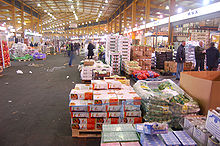This article has multiple issues. Please help improve it or discuss these issues on the talk page. (Learn how and when to remove these messages)
|
Wholesaling or distributing is the sale of goods or merchandise to retailers; to industrial, commercial, institutional or other professional business users; or to other wholesalers (wholesale businesses) and related subordinated services. In general, it is the sale of goods in bulk to anyone, either a person or an organization, other than the end consumer of that merchandise. Wholesaling is buying goods in bulk quantity, usually directly from the manufacturer or source, at a discounted rate. The retailer then sells the goods to the end consumer at a higher price making a profit.[1]

According to the United Nations Statistics Division, wholesale is the resale of new and used goods to retailers, to industrial, commercial, institutional or professional users, or to other wholesalers, or involves acting as an agent or broker in buying merchandise for, or selling merchandise to, such persons or companies. Wholesalers frequently physically assemble, sort, and grade goods in large lots, break-bulk, repack, and redistribute in smaller lots.[2] While wholesalers of most products usually operate from independent premises, wholesale marketing for foodstuffs can take place at specific wholesale markets where all traders are congregated.
Traditionally, wholesalers were closer to the markets they supplied than the source from which they got the products.[3] However, with the advent of the internet and e-procurement there is an increasing number of wholesalers located nearer to the manufacturers in China, Taiwan, and Southeast Asia. The profit margins of wholesalers depend largely on their ability to achieve market competitive transaction costs.
In the banking industry "wholesale" usually refers to wholesale banking, providing tailored services to large customers, in contrast with retail banking, providing standardized services to large numbers of smaller customers.
In real estate, wholesaling is the act of contracting to purchase real property, and assigning that contract to an investor.
Taxes
editOften, in the United States, wholesalers are not required to charge their buyers sales tax, if the buyer has a resale license in the state the wholesaler is located. Out-of-state buyers are not charged sale tax by wholesalers.[4]
In China, wholesalers are subject to a Value-Added Tax (VAT) of either 9% or 13% on imported goods, depending on the type of product.[5][6] Additionally, consumption tax is levied on products such as tobacco, alcohol, and luxury goods. These taxes are part of China's broader strategy to promote domestic consumption and regulate imports.[7] On the other hand, Vietnam imposes a standard VAT rate of 10% on most goods and services, with exemptions for certain agricultural products and essential services.[8][9] In Europe, Value-Added Tax (VAT) rates vary among member states, with a standard rate that cannot be less than 15%.[10][11] Countries like Hungary, Croatia, Denmark, and Sweden have higher standard VAT rates, while Luxembourg, Malta, Cyprus, Germany, and Romania have lower rates.[12]
Direct selling
editThe alternative to selling wholesale to distributors or retailers is to sell retail[13] either through company-owned stores or online. Advantages include receiving a larger slice of the price paid by the consumer; disadvantages include difficulty in reaching consumers.[14] Direct selling is a business model wherein sellers sell the goods directly to the end customer.[15]
See also
editReferences
edit- ^ Kolodny, Joseph (September 1949). "The Mechanics of Wholesaling". Journal of Marketing. 14 (2): 225–231. doi:10.2307/1247896. ISSN 0022-2429. JSTOR 1247896.
- ^ "United Nations Statistics Division – Classifications Registry". unstats.un.org. Archived from the original on 21 March 2018. Retrieved 8 May 2018.
- ^ Chandler, A. D. (1994). Scale and scope The Dynamics of Industrial Capitalism. Cambridge, Massachusetts: Belknap Press of Harvard Univ. Press. p. 29.
- ^ Michael Gravette, wholesaler for 32 years.
- ^ "What taxes are involved when goods are imported into China?". EU SME Centre: China Market Research, Training, Advice | Get Ready for China. Retrieved 31 October 2024.
- ^ "Import-Export Taxes and Duties in China in 2022". China Briefing News. 22 December 2021. Retrieved 31 October 2024.
- ^ Zhang, Deyong (1 September 2022). "Consumption Tax Reform in Accelerating the Establishment of a New Development Paradigm". China Finance and Economic Review. 11 (2): 117–128. doi:10.1515/cfer-2022-0013. ISSN 2196-5633.
- ^ Inc IBP (1 June 2015). Vietnam: Doing Business and Investing in Vietnam Guide Volume 1 Strategic, Practical Information and Contacts. Lulu.com. ISBN 978-1-5145-2818-1.
- ^ Nam Nguyen (8 January 2022). "Wholesale suppliers Vietnam". SourceVietNam. Retrieved 31 October 2024.
- ^ "VAT rules and rates: standard, special & reduced rates". Your Europe. Retrieved 31 October 2024.
- ^ "VAT - European Commission". taxation-customs.ec.europa.eu. Retrieved 31 October 2024.
- ^ Mengden, Alex (30 January 2024). "2024 VAT Rates in Europe". Tax Foundation. Retrieved 31 October 2024.
- ^ "Als Lieferant mitmachen" (in German). eu-lieferanten.de. Archived from the original on 11 April 2013. Retrieved 9 April 2013.
- ^ Mount, Ian (6 March 2013). "Clothing Companies Trying to Find More Direct Paths to Customers". The New York Times. Archived from the original on 7 March 2013. Retrieved 7 March 2013.
- ^ "July". Some Things You Should Know. Bloomsbury Academic. 2020. doi:10.5040/9781350115408.ch-007. ISBN 978-1-3501-1340-4. Retrieved 24 November 2021.